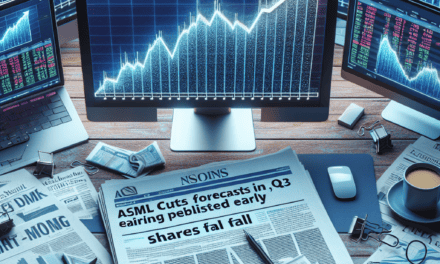“Market Slump: Hopes for Rate Cuts Fade, Dow, S&P 500, Nasdaq Tumble”
Introduction
In recent trading sessions, the stock market has experienced a notable downturn, with major indices such as the Dow Jones Industrial Average, the S&P 500, and the Nasdaq Composite all registering declines. This shift in market sentiment comes amid diminishing expectations for imminent interest rate cuts by the Federal Reserve. Investors, who had previously anticipated potential rate reductions to counter economic uncertainties, are now recalibrating their strategies in response to signals from the central bank suggesting a more cautious approach to monetary easing. The recalibration has led to increased volatility and a reassessment of asset valuations, as market participants digest the implications of a prolonged period of higher interest rates on corporate earnings and economic growth.
Impact Of Diminished Rate-Cut Expectations On The Stock Market
The stock market experienced a notable downturn recently, with the Dow Jones Industrial Average, the S&P 500, and the Nasdaq Composite all registering declines. This downward trend can be attributed to diminishing expectations of interest rate cuts by the Federal Reserve, a development that has significant implications for investors and the broader economy. As market participants recalibrate their strategies in response to shifting monetary policy signals, the impact on stock valuations and investor sentiment becomes increasingly evident.
To understand the current market dynamics, it is essential to consider the role of interest rates in shaping investment decisions. Lower interest rates generally encourage borrowing and spending, which can stimulate economic growth and, in turn, boost corporate earnings. Consequently, the prospect of rate cuts often leads to increased investor optimism, driving stock prices higher. However, when expectations of such cuts diminish, as is currently the case, the opposite effect can occur. Investors may become more cautious, leading to a sell-off in equities as they reassess the potential for future growth.
The Federal Reserve’s recent communications have played a pivotal role in shaping these expectations. While the central bank had previously signaled a willingness to adjust rates in response to economic conditions, recent statements suggest a more measured approach. This shift is largely due to a combination of factors, including robust economic data and persistent inflationary pressures. As a result, the likelihood of imminent rate cuts has decreased, prompting investors to reevaluate their positions.
In addition to the direct impact on stock prices, diminished rate-cut expectations can also influence market volatility. As investors adjust to the new monetary policy landscape, fluctuations in stock prices may become more pronounced. This increased volatility can create both challenges and opportunities for market participants. On one hand, it may lead to heightened uncertainty and risk aversion, causing some investors to seek safer assets such as bonds or gold. On the other hand, it can also present opportunities for those willing to navigate the turbulence and capitalize on short-term price movements.
Moreover, the broader economic implications of diminished rate-cut expectations cannot be overlooked. As borrowing costs remain elevated, businesses may face higher expenses, potentially impacting their profitability and investment plans. This, in turn, could have a ripple effect on employment and consumer spending, further influencing the stock market’s trajectory. Additionally, sectors that are particularly sensitive to interest rates, such as real estate and utilities, may experience more pronounced effects, as their cost structures and revenue models are closely tied to borrowing costs.
In conclusion, the recent decline in the Dow, S&P 500, and Nasdaq underscores the significant impact that diminished rate-cut expectations can have on the stock market. As investors navigate this evolving landscape, they must remain vigilant and adaptable, considering both the immediate and long-term implications of monetary policy shifts. While the path forward may be fraught with challenges, it also presents opportunities for those who can effectively manage risk and seize potential gains. As always, a careful analysis of economic indicators and central bank communications will be crucial in guiding investment decisions in this complex environment.
Analyzing The Dow’s Recent Decline Amid Economic Shifts
The recent decline in the Dow Jones Industrial Average, alongside the S&P 500 and Nasdaq, has captured the attention of investors and analysts alike, as shifting economic conditions and diminishing expectations for rate cuts have contributed to market volatility. This downturn can be attributed to a confluence of factors, each playing a significant role in shaping investor sentiment and market dynamics. As we delve into the intricacies of these developments, it becomes evident that the interplay between economic indicators and monetary policy expectations is crucial in understanding the current market landscape.
To begin with, the anticipation of interest rate cuts by the Federal Reserve has been a pivotal factor influencing market behavior in recent months. Investors had been hopeful that the central bank would implement rate cuts to stimulate economic growth amid signs of a slowing economy. However, recent statements from Federal Reserve officials have tempered these expectations, suggesting a more cautious approach to monetary policy. This shift in sentiment has led to increased uncertainty, as market participants reassess their strategies in light of the possibility that rates may remain higher for longer than previously anticipated.
Moreover, the economic data released in recent weeks has painted a mixed picture of the U.S. economy, further complicating the outlook for interest rates. On one hand, certain indicators, such as employment figures and consumer spending, have shown resilience, suggesting that the economy is not in immediate danger of a downturn. On the other hand, other metrics, including manufacturing output and business investment, have exhibited signs of weakness, raising concerns about the sustainability of economic growth. This dichotomy has made it challenging for investors to gauge the Federal Reserve’s next moves, thereby contributing to market volatility.
In addition to domestic economic factors, global developments have also played a role in the recent market decline. Geopolitical tensions, trade disputes, and economic slowdowns in key regions such as Europe and Asia have added layers of complexity to the investment landscape. These external factors have heightened risk aversion among investors, prompting a shift away from equities and towards safer assets such as bonds and gold. Consequently, this reallocation of capital has exerted downward pressure on stock indices, including the Dow, S&P 500, and Nasdaq.
Furthermore, corporate earnings reports have been a mixed bag, with some companies exceeding expectations while others have issued cautious outlooks. This variability in earnings performance has contributed to sector-specific fluctuations, as investors react to the latest financial results and guidance. Technology stocks, in particular, have experienced notable volatility, given their significant weight in major indices and their sensitivity to changes in interest rate expectations.
As we consider the broader implications of these developments, it is clear that the stock market’s recent decline is not solely a reflection of diminished rate-cut expectations but rather a confluence of interconnected factors. The interplay between economic indicators, monetary policy, global events, and corporate performance underscores the complexity of the current market environment. Investors must navigate this landscape with a keen awareness of the multifaceted influences at play, as they seek to make informed decisions in an era of heightened uncertainty.
In conclusion, the recent downturn in the Dow, S&P 500, and Nasdaq serves as a reminder of the intricate web of factors that drive market movements. As economic conditions continue to evolve and monetary policy remains a focal point of investor attention, market participants must remain vigilant and adaptable in their approach. By understanding the underlying dynamics at work, investors can better position themselves to navigate the challenges and opportunities that lie ahead.
S&P 500 Performance: Factors Behind The Recent Downturn
The recent downturn in the S&P 500 has captured the attention of investors and analysts alike, as the index, along with the Dow and Nasdaq, has experienced a notable decline. This shift in market sentiment can be attributed to a confluence of factors, with diminishing expectations for interest rate cuts playing a pivotal role. As the Federal Reserve’s monetary policy remains a focal point for market participants, the anticipation of rate cuts has been a significant driver of stock market performance in recent months. However, recent economic data and statements from Federal Reserve officials have tempered these expectations, leading to a reassessment of market valuations.
To begin with, the robust economic indicators have contributed to the recalibration of rate-cut expectations. Recent reports have shown stronger-than-expected job growth, rising consumer spending, and resilient manufacturing activity. These positive economic signals suggest that the economy is on a stable footing, reducing the urgency for the Federal Reserve to implement rate cuts as a stimulus measure. Consequently, investors have adjusted their outlook, leading to a repricing of assets and a subsequent decline in the S&P 500.
Moreover, inflationary pressures have also played a significant role in shaping market dynamics. With inflation rates remaining elevated, the Federal Reserve faces the challenge of balancing economic growth with price stability. The central bank’s commitment to its dual mandate of promoting maximum employment and stable prices has led to a cautious approach in altering interest rates. As a result, the likelihood of imminent rate cuts has diminished, prompting investors to reassess their strategies and contributing to the recent downturn in the S&P 500.
In addition to domestic factors, global economic conditions have also influenced the performance of the S&P 500. Geopolitical tensions, trade uncertainties, and fluctuations in international markets have added layers of complexity to the investment landscape. For instance, ongoing trade negotiations between major economies have introduced an element of unpredictability, affecting investor confidence and market stability. Furthermore, the interconnectedness of global financial markets means that developments in one region can have ripple effects across others, further complicating the outlook for the S&P 500.
Another factor contributing to the recent decline is the valuation concerns that have emerged as stock prices reached elevated levels. The prolonged period of low interest rates had previously fueled a rally in equities, pushing valuations to historically high levels. As expectations for rate cuts wane, investors are reevaluating whether current stock prices accurately reflect underlying fundamentals. This reassessment has led to increased volatility and downward pressure on the S&P 500 as market participants seek to align valuations with the evolving economic landscape.
In conclusion, the recent downturn in the S&P 500 can be attributed to a combination of factors, including diminishing expectations for interest rate cuts, robust economic indicators, inflationary pressures, global economic conditions, and valuation concerns. As investors navigate this complex environment, the interplay between these elements will continue to shape market dynamics. While the path forward remains uncertain, understanding the underlying factors driving the recent downturn provides valuable insights for market participants seeking to make informed investment decisions. As always, staying attuned to economic developments and central bank communications will be crucial in navigating the evolving landscape of the stock market.
Nasdaq’s Fall: Technology Stocks And Interest Rate Concerns

In recent trading sessions, the Nasdaq Composite Index has experienced a notable decline, driven primarily by concerns surrounding technology stocks and shifting expectations regarding interest rate cuts. This downturn in the Nasdaq, which is heavily weighted with technology companies, reflects broader market apprehensions about the future trajectory of monetary policy and its implications for growth-oriented sectors.
The technology sector, often seen as a bellwether for innovation and economic dynamism, has been particularly sensitive to changes in interest rate expectations. As investors recalibrate their portfolios in response to evolving economic signals, technology stocks have borne the brunt of this adjustment. The anticipation of prolonged higher interest rates has led to a reevaluation of the valuations of tech companies, many of which are characterized by high growth potential but also significant capital requirements. Higher interest rates can increase borrowing costs and reduce the present value of future earnings, making these stocks less attractive to investors seeking stable returns.
Moreover, the Federal Reserve’s recent communications have played a pivotal role in shaping market sentiment. Initially, there was widespread speculation that the central bank might pivot towards a more accommodative stance, potentially cutting rates to support economic growth. However, recent statements from Fed officials have tempered these expectations, emphasizing a commitment to maintaining current rates until inflationary pressures are convincingly subdued. This hawkish tone has dampened hopes for imminent rate cuts, leading to increased volatility in the stock market.
In addition to interest rate concerns, the technology sector is grappling with other challenges that have contributed to the Nasdaq’s decline. Supply chain disruptions, geopolitical tensions, and regulatory scrutiny are among the factors that have created an uncertain environment for tech companies. These issues have compounded the difficulties faced by the sector, further eroding investor confidence and contributing to the downward pressure on stock prices.
Despite these challenges, it is important to recognize that the technology sector remains a critical driver of economic growth and innovation. Companies within this space continue to invest in research and development, pushing the boundaries of what is possible in areas such as artificial intelligence, cloud computing, and renewable energy. While short-term market fluctuations can be unsettling, the long-term prospects for technology remain robust, underpinned by a relentless pursuit of advancement and efficiency.
As investors navigate this complex landscape, diversification and strategic asset allocation become increasingly important. By spreading investments across different sectors and asset classes, investors can mitigate the risks associated with market volatility and interest rate fluctuations. Additionally, maintaining a long-term perspective can help investors weather short-term market disruptions and capitalize on the growth potential of technology stocks over time.
In conclusion, the recent decline in the Nasdaq Composite Index underscores the intricate interplay between interest rate expectations and the performance of technology stocks. While the current environment presents challenges, it also offers opportunities for discerning investors who are willing to look beyond immediate market movements. As the economic landscape continues to evolve, staying informed and adaptable will be key to navigating the complexities of the stock market and achieving long-term investment success.
Investor Sentiment: How Rate-Cut Speculation Influences Market Trends
Investor sentiment plays a crucial role in shaping market trends, and recent developments have highlighted the significant impact of rate-cut speculation on the stock market. As the Dow, S&P 500, and Nasdaq experienced declines, the diminishing expectations for rate cuts have emerged as a pivotal factor influencing investor behavior. Understanding the dynamics of this relationship is essential for comprehending the broader market movements.
To begin with, interest rates are a fundamental component of economic policy, influencing borrowing costs, consumer spending, and business investment. When central banks, such as the Federal Reserve, signal potential rate cuts, it often leads to increased optimism among investors. Lower interest rates generally reduce the cost of borrowing, encouraging businesses to expand and consumers to spend more, thereby stimulating economic growth. Consequently, the anticipation of rate cuts can drive stock prices higher as investors foresee a more favorable economic environment.
However, the recent decline in the major stock indices underscores the complexity of investor sentiment. As expectations for rate cuts have diminished, investors have reassessed their positions, leading to a sell-off in equities. This shift in sentiment can be attributed to several factors. Firstly, stronger-than-expected economic data has tempered the urgency for rate cuts. Indicators such as robust job growth, rising consumer confidence, and resilient manufacturing output suggest that the economy may not require immediate monetary easing. As a result, the likelihood of rate cuts diminishes, prompting investors to adjust their portfolios accordingly.
Moreover, central bank communications play a pivotal role in shaping rate-cut expectations. Recent statements from Federal Reserve officials have emphasized a data-dependent approach, indicating that any decision to alter interest rates will be contingent on economic conditions. This cautious stance has further dampened hopes for imminent rate cuts, contributing to the market’s downward trajectory. Investors, who had previously priced in the likelihood of rate reductions, are now recalibrating their strategies in response to this evolving narrative.
In addition to economic indicators and central bank communications, geopolitical factors also influence rate-cut speculation and, consequently, investor sentiment. Trade tensions, political uncertainties, and global economic developments can all sway expectations regarding monetary policy. For instance, a resolution to trade disputes or a stabilization of geopolitical tensions could reduce the perceived need for rate cuts, impacting market trends. Conversely, escalating conflicts or economic slowdowns in key regions might reignite hopes for monetary easing, thereby influencing investor behavior.
As investors navigate this complex landscape, it is essential to recognize the interplay between rate-cut speculation and market trends. While the prospect of lower interest rates can initially boost investor confidence, the subsequent recalibration of expectations can lead to volatility. This underscores the importance of a nuanced understanding of economic indicators, central bank communications, and geopolitical developments in shaping investor sentiment.
In conclusion, the recent decline in the Dow, S&P 500, and Nasdaq highlights the intricate relationship between rate-cut speculation and market trends. As expectations for rate cuts diminish, investors are reevaluating their positions, leading to fluctuations in stock prices. By closely monitoring economic data, central bank communications, and geopolitical factors, investors can gain valuable insights into the evolving landscape and make informed decisions. Ultimately, understanding how rate-cut speculation influences investor sentiment is crucial for navigating the complexities of the stock market.
Comparing Historical Market Reactions To Interest Rate Changes
In the ever-evolving landscape of financial markets, the interplay between interest rates and stock market performance remains a focal point for investors and analysts alike. Recently, the Dow Jones Industrial Average, S&P 500, and Nasdaq Composite have experienced declines as expectations for imminent interest rate cuts have diminished. To understand the current market dynamics, it is instructive to compare historical market reactions to changes in interest rate policies.
Historically, interest rate adjustments by central banks, particularly the Federal Reserve in the United States, have had significant impacts on stock market behavior. When interest rates are lowered, borrowing costs decrease, encouraging businesses to invest and consumers to spend, which can stimulate economic growth. Consequently, lower interest rates often lead to bullish market sentiments, as investors anticipate improved corporate earnings and economic expansion. Conversely, when interest rates rise, borrowing becomes more expensive, potentially slowing down economic activity and dampening investor enthusiasm.
Examining past instances, such as the rate cuts during the financial crisis of 2008, provides valuable insights. During this period, the Federal Reserve slashed interest rates to near-zero levels in an effort to stabilize the economy. The stock market, initially in turmoil, eventually responded positively to these measures, with major indices recovering and embarking on a prolonged bull run. This historical precedent underscores the market’s sensitivity to monetary policy and the potential for rate cuts to act as a catalyst for market recovery.
However, the relationship between interest rates and stock market performance is not always straightforward. For instance, in the late 1990s, the Federal Reserve raised interest rates multiple times to curb inflationary pressures during the dot-com boom. Despite these rate hikes, the stock market continued to soar, driven by investor exuberance and technological advancements. This anomaly highlights that while interest rates are a critical factor, they are not the sole determinant of market trends. Other elements, such as technological innovation, geopolitical events, and investor sentiment, also play pivotal roles.
In the current context, the recent decline in the Dow, S&P 500, and Nasdaq can be attributed to a recalibration of investor expectations regarding future interest rate cuts. Initially, there was optimism that the Federal Reserve might lower rates to counteract economic uncertainties. However, robust economic data and persistent inflationary pressures have led to a reassessment of this outlook. As a result, investors are adjusting their portfolios in anticipation of a more prolonged period of elevated interest rates.
Moreover, the global economic landscape adds another layer of complexity. Central banks worldwide are grappling with similar challenges, balancing the need to control inflation with the desire to support growth. This synchronized approach to monetary policy can amplify the effects of interest rate changes on global markets, leading to heightened volatility and uncertainty.
In conclusion, while historical patterns provide a framework for understanding the relationship between interest rates and stock market performance, each economic cycle presents unique challenges and opportunities. As the Dow, S&P 500, and Nasdaq navigate the current environment of diminished rate-cut expectations, investors must remain vigilant, considering a multitude of factors that influence market dynamics. By drawing lessons from the past and staying attuned to present conditions, market participants can better position themselves to navigate the complexities of today’s financial landscape.
Strategies For Investors During Periods Of Market Volatility
In the ever-evolving landscape of financial markets, investors are often faced with periods of volatility that can test even the most seasoned individuals. Recently, the Dow, S&P 500, and Nasdaq have experienced declines as expectations for rate cuts have diminished. This shift in sentiment has left many investors pondering the best strategies to navigate these turbulent times. Understanding the underlying factors contributing to market volatility is crucial for developing effective strategies. The recent downturn can be attributed to a combination of economic indicators, geopolitical tensions, and central bank policies. As rate-cut expectations wane, investors are recalibrating their portfolios to adapt to a potentially prolonged period of higher interest rates. This environment necessitates a strategic approach to mitigate risks and capitalize on opportunities.
One effective strategy during periods of market volatility is diversification. By spreading investments across various asset classes, sectors, and geographic regions, investors can reduce the impact of adverse movements in any single area. Diversification acts as a buffer, allowing for potential gains in one segment to offset losses in another. This approach not only helps in managing risk but also positions investors to benefit from different market cycles. In addition to diversification, maintaining a long-term perspective is essential. Market volatility often triggers emotional responses, leading to impulsive decisions that can be detrimental to investment goals. By focusing on long-term objectives and adhering to a well-thought-out investment plan, investors can avoid the pitfalls of short-term market fluctuations. This disciplined approach enables individuals to ride out periods of volatility and potentially emerge stronger when markets stabilize.
Moreover, during volatile times, it is prudent for investors to reassess their risk tolerance. Understanding one’s risk appetite is fundamental to making informed investment decisions. By aligning investments with personal risk tolerance, investors can avoid undue stress and make rational choices that align with their financial goals. This reassessment may involve adjusting asset allocations or exploring alternative investments that offer stability in uncertain times. Another strategy to consider is the use of dollar-cost averaging. This technique involves investing a fixed amount of money at regular intervals, regardless of market conditions. By doing so, investors can purchase more shares when prices are low and fewer when prices are high, effectively reducing the average cost per share over time. Dollar-cost averaging not only mitigates the impact of market volatility but also instills a disciplined approach to investing.
Furthermore, staying informed about market trends and economic developments is vital. Informed investors are better equipped to anticipate potential market shifts and adjust their strategies accordingly. Regularly reviewing financial news, attending webinars, and consulting with financial advisors can provide valuable insights that aid in making informed decisions. Lastly, maintaining liquidity is a crucial consideration during volatile periods. Having access to cash or liquid assets allows investors to seize opportunities that may arise during market downturns. This liquidity can be used to purchase undervalued assets or rebalance portfolios in response to changing market conditions. In conclusion, while market volatility can be unsettling, it also presents opportunities for astute investors. By employing strategies such as diversification, maintaining a long-term perspective, reassessing risk tolerance, utilizing dollar-cost averaging, staying informed, and ensuring liquidity, investors can navigate these challenging times with confidence. As the Dow, S&P 500, and Nasdaq continue to fluctuate, adopting a strategic approach will be key to achieving financial objectives and weathering the storm of market uncertainty.
Q&A
1. **What caused the recent decline in the Dow, S&P 500, and Nasdaq?**
The decline was primarily due to diminishing expectations for rate cuts by the Federal Reserve.
2. **How did investor sentiment shift regarding interest rates?**
Investors adjusted their expectations, anticipating that the Federal Reserve might maintain higher interest rates for a longer period.
3. **What economic indicators influenced the market’s performance?**
Strong economic data, such as robust employment figures or higher-than-expected inflation, contributed to the shift in rate-cut expectations.
4. **Which sectors were most affected by the market downturn?**
Technology and growth-oriented sectors, which are sensitive to interest rate changes, were among the most affected.
5. **How did bond yields react to the changing rate expectations?**
Bond yields typically rose as investors priced in the likelihood of prolonged higher interest rates.
6. **What impact did the market decline have on investor portfolios?**
Many investors saw a decrease in the value of their portfolios, particularly those heavily invested in tech and growth stocks.
7. **What are analysts predicting for the future market trend?**
Analysts are cautious, suggesting that market volatility may continue as investors await further guidance from the Federal Reserve and additional economic data.
Conclusion
The recent decline in the Dow, S&P 500, and Nasdaq indices reflects investor concerns over diminishing expectations for interest rate cuts. As economic indicators suggest resilience, the Federal Reserve may maintain or even increase rates to combat inflation, leading to market volatility. This shift in monetary policy outlook has prompted a reassessment of asset valuations, particularly in interest-sensitive sectors, contributing to the downward pressure on stock prices. Investors are now recalibrating their strategies in anticipation of a potentially prolonged period of higher interest rates.





